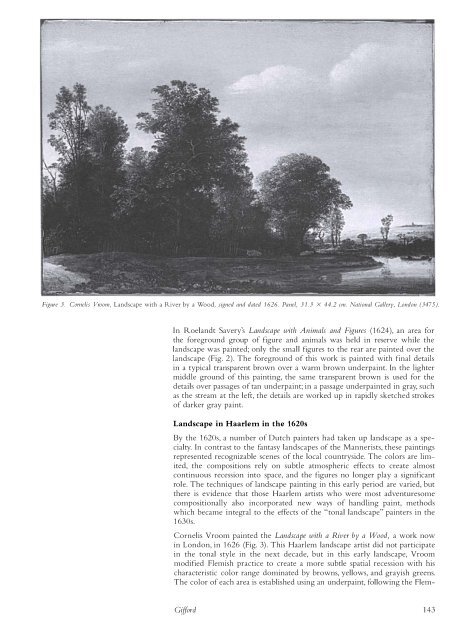Historical Painting Techniques, Materials, and Studio Practice
Create successful ePaper yourself
Turn your PDF publications into a flip-book with our unique Google optimized e-Paper software.
Figure 3. Camelis Vroom, L<strong>and</strong>scape with a River by a Wood, signed <strong>and</strong> dated 1626. Panel, 31.3 X 44.2 em. National Gallery, London (3475).<br />
In Roel<strong>and</strong>t Savery's L<strong>and</strong>scape with Animals <strong>and</strong> Figures (1624), an area for<br />
the foreground group of figure <strong>and</strong> animals was held in reserve while the<br />
l<strong>and</strong>scape was painted; only the small figures to the rear are painted over the<br />
l<strong>and</strong>scape (Fig. 2). The foreground of this work is painted with final details<br />
in a typical transparent brown over a warm brown underpaint. In the lighter<br />
middle ground of this painting, the same transparent brown is used for the<br />
details over passages of tan underpaint; in a passage underpainted in gray, such<br />
as the stream at the left, the details are worked up in rapidly sketched strokes<br />
of darker gray paint.<br />
L<strong>and</strong>scape in Haarlem in the 1620s<br />
By the 1620s, a number of Dutch painters had taken up l<strong>and</strong>scape as a specialty.<br />
In contrast to the fantasy l<strong>and</strong>scapes of the Mannerists, these paintings<br />
represented recognizable scenes of the local countryside. The colors are limited,<br />
the compositions rely on subtle atmospheric effects to create almost<br />
continuous recession into space, <strong>and</strong> the figures no longer play a significant<br />
role. The techniques of l<strong>and</strong>scape painting in this early period are varied, but<br />
there is evidence that those Haarlem artists who were most adventuresome<br />
compositionally also incorporated new ways of h<strong>and</strong>ling paint, methods<br />
which became integral to the effects of the "tonal l<strong>and</strong>scape" painters in the<br />
1630s.<br />
Comelis Vroom painted the L<strong>and</strong>scape with a River by a Wood, a work now<br />
in London, in 1626 (Fig. 3) . This Haarlem l<strong>and</strong>scape artist did not participate<br />
in the tonal style in the next decade, but in this early l<strong>and</strong>scape, Vroom<br />
modified Flemish practice to create a more subtle spatial recession with his<br />
characteristic color range dominated by browns, yellows, <strong>and</strong> grayish greens.<br />
The color of each area is established using an underpaint, following the Flem-<br />
Giff ord 143


